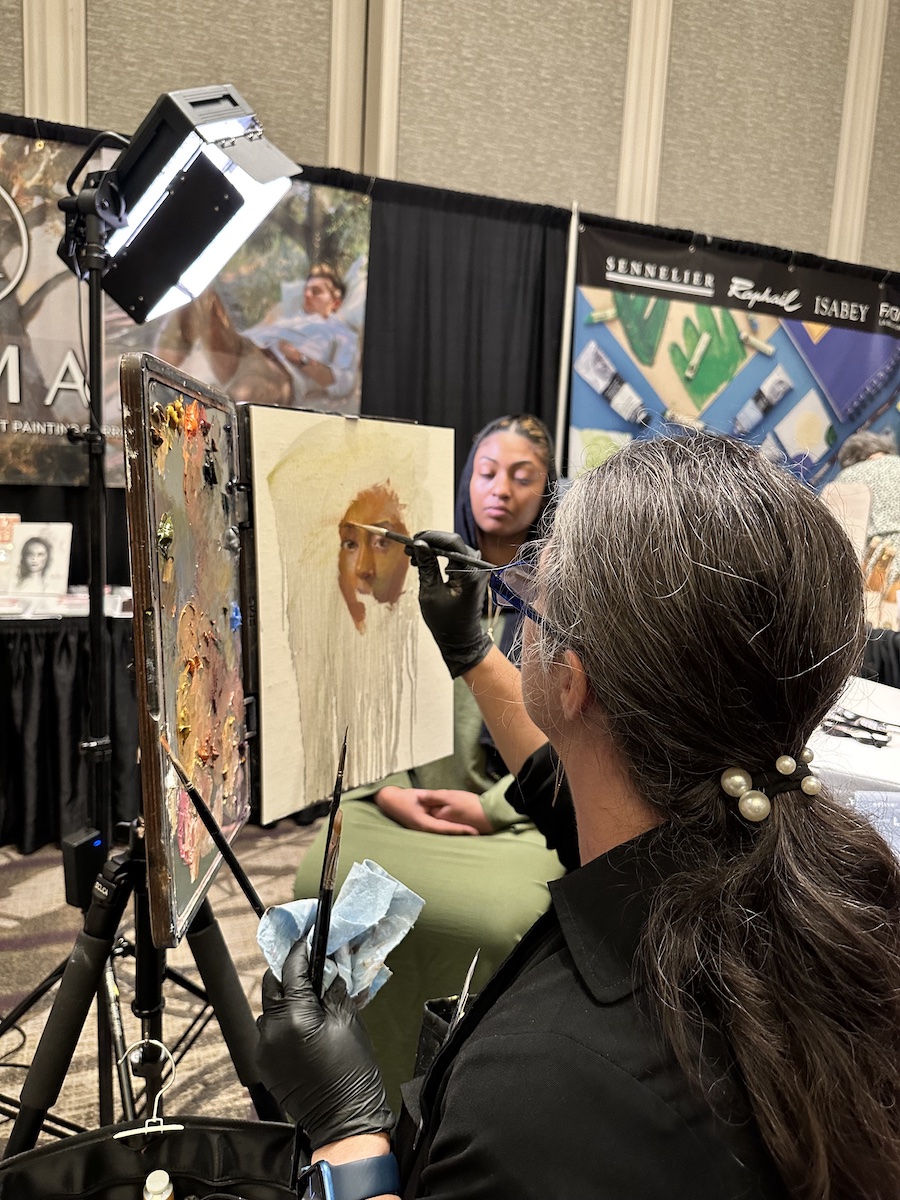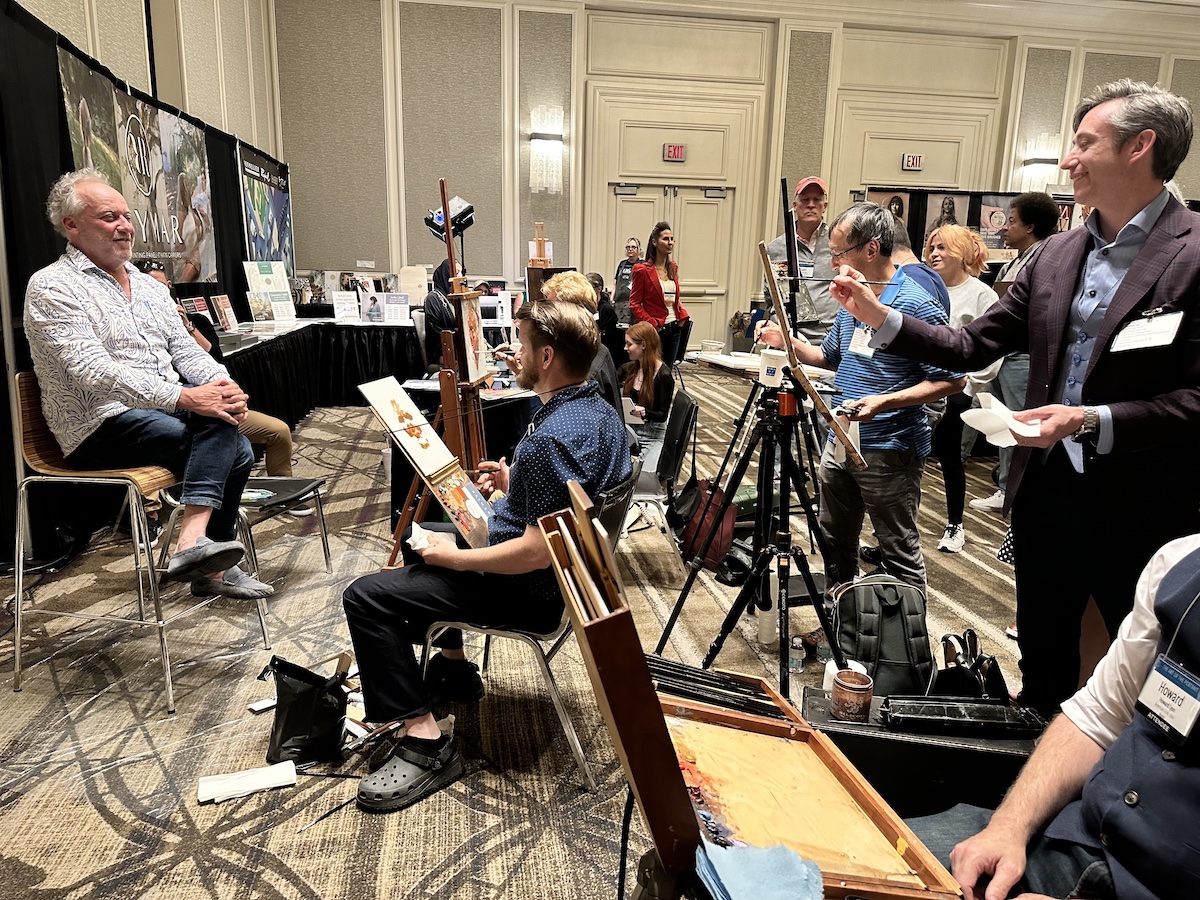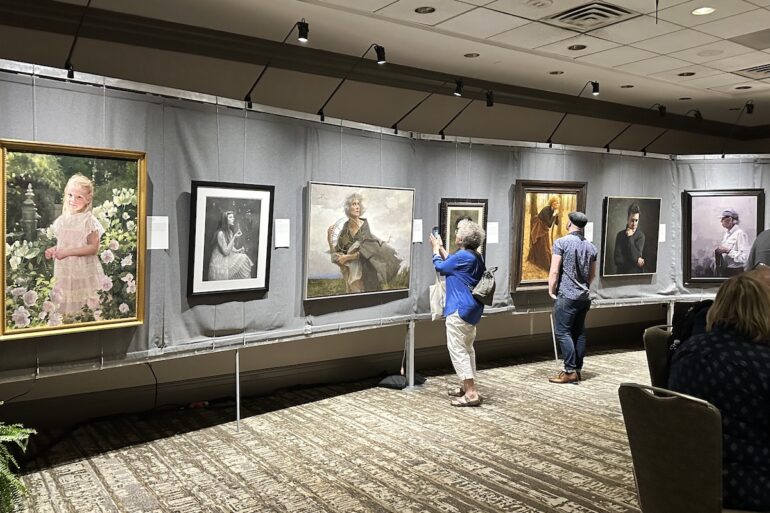
This post is also available in:

It’s Michael Shane Neal, chief of the Portrait Society of America, who does the honors at the official opening of The Art of The Portrait, the convention established as an annual fixture by the Portrait Society of America, which is celebrating its 25th anniversary this year.
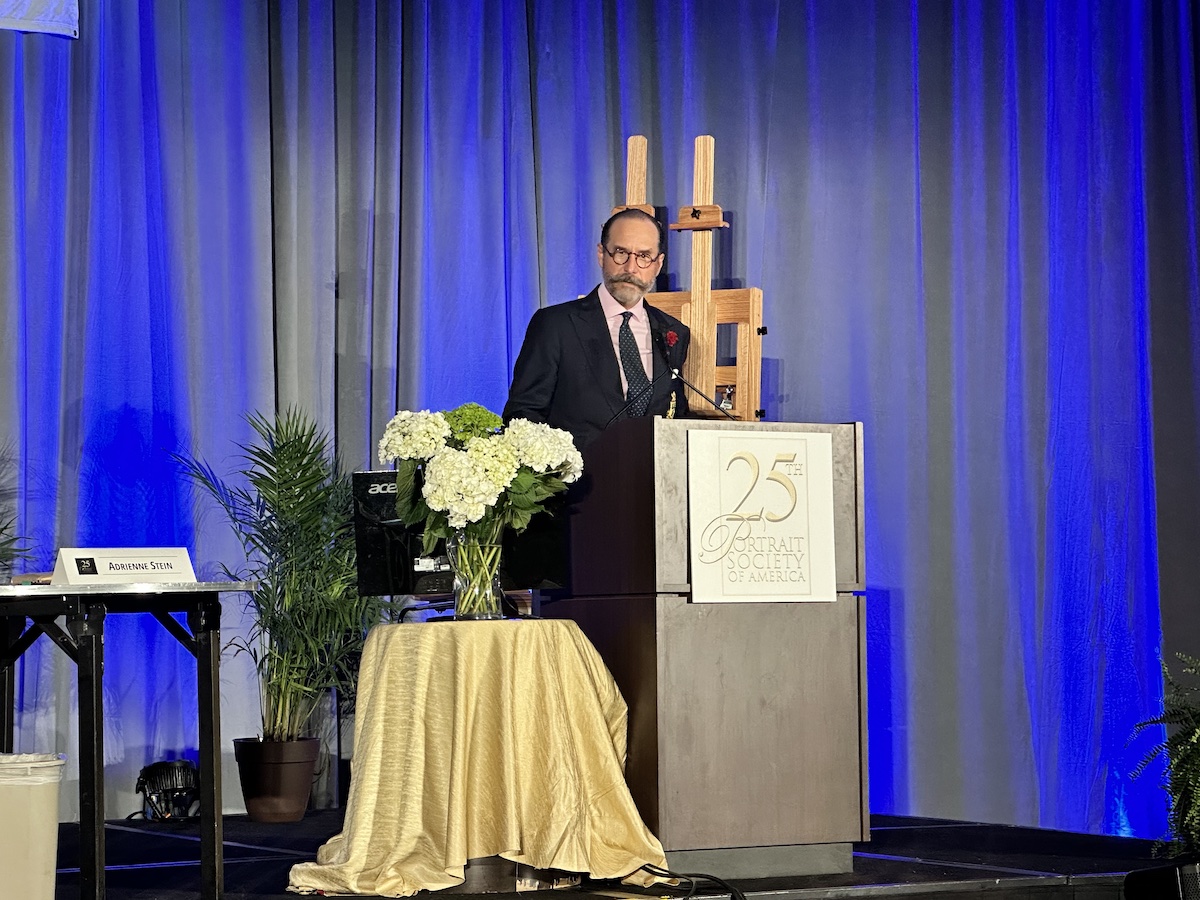
The first guest of the day was Burton Silverman, a Living Legend. Silverman officiated -virtually- the convention. He stated that portraiture represents a combination of subjectivity and objectivity, of space and time. “Portraiture, like figurative art, represents the history of the world that comes to us through art,” said the artist.
An artist over ninety years old, Burton Silverman has thirty-six solo shows to his credit with as many as forty-two works exhibited between museums and private collections. He has been the recipient of some of the most prestigious awards, including the Golden Medal from the Portrait Society of America in 2004: the highest honor given to artists who have devoted themselves with devotion and passion to excellence both in their work and in educating their colleagues.
In his speech, crafted especially for the convention, Silverman launched a provocation with which he highlighted the reductiveness of the adjective “beautiful” with which we tend to apostrophize a work of art. According to Silverman, beauty is among the least important components in art. “What matters is communicative power, the ability to reach out with people,” the artist said.
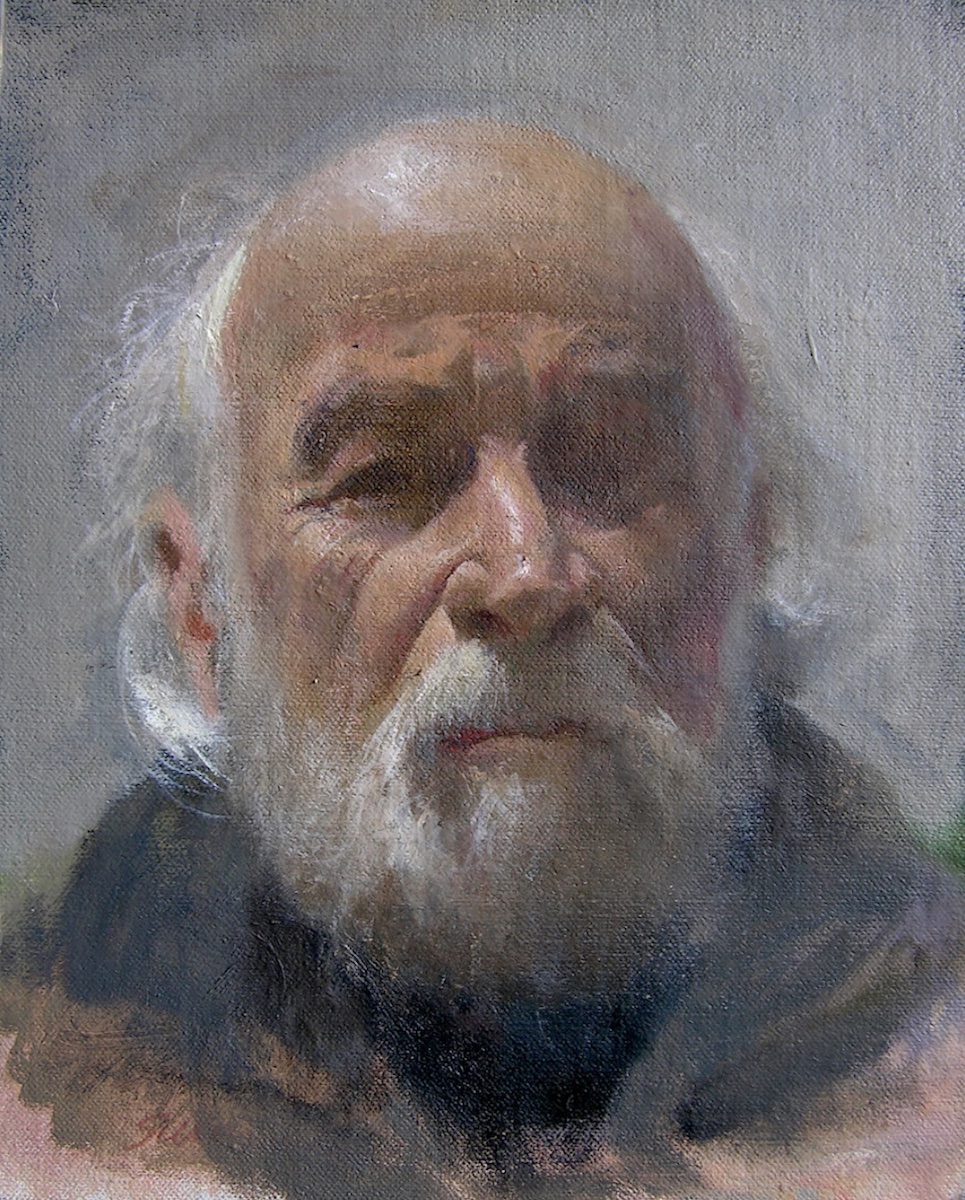
Bringing up similarities between his artistic background and some of the most important artists in the history of art-past and contemporary-he pointed out how the background -most of the time only sketched out by most artists- plays instead a key role in catalyzing the viewer’s attention.
The background, which can be detailedly described or summarily depicted, is a key element in charging the emotional power of the work. Among the many examples, he mentioned the “Woodgatherer,” by Jules Bastien-Lepage.
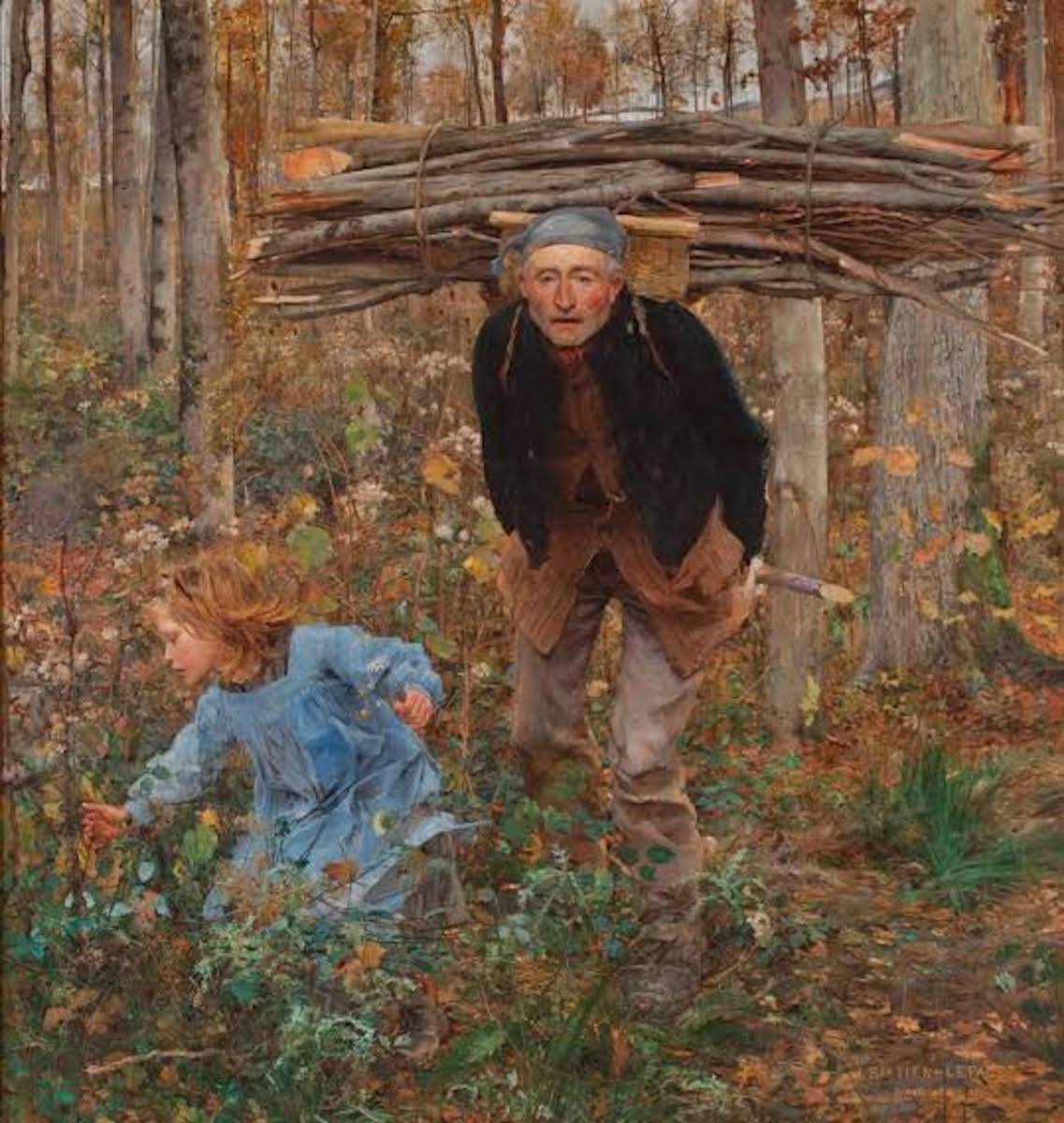
The first demonstration session of the day was by the duo: Adrienne Stein -Anthony Ryder, moderated by Jeff Hein, a great artist and sympathetic commentator.
The duo who demonstrated, in a rigorous manner, their approach to art, in terms of: “Structure and Style: Building Personal Expression on a Solid Foundation”, demonstrated a diametrically different approach if only from the choice of mediums: oil for Stein, who makes use of a rich color palette of saturated colors, predominantly Sennelier and Michael Harding, and pencil for Ryder, who sharpens in an almost meditative manner. A procedure that conceptually references the centuries-old art of carving, because of the speed and precision of execution.
The construction of the face for Ryder represents, “a constellation of landmarks by which the connections between the parts are made,” said the artist, wh, starting from a generic mapping identifies the unique characteristics of each individual.
If oil painting for Adrienne Stein is an excellent tool for correcting any compositional errors, for Anthony Ryder, compositional control is achieved through triangulation.
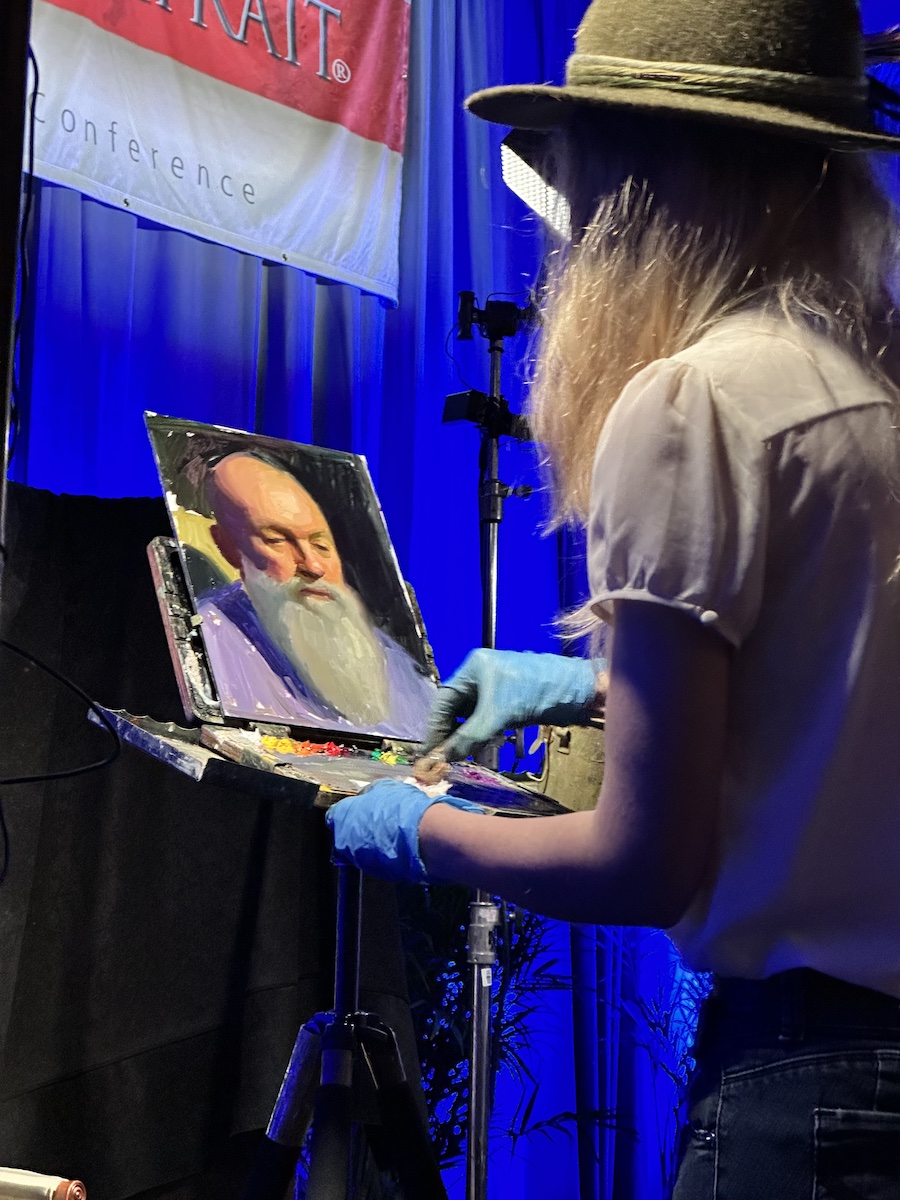
Adrienne Stein, on the other hand, has a looser but equally rigorous approach and in compositional construction she begins with a basic structural mapping on which she models the masses, emphasized by the use of colors. Ryder, on the other hand approaches the study of the subject with a viewcatcher, which allows him to focus on the compositional elements and their proportions, also establishing the subject’s position within the compositional space.
According to Ryder, the composition represents a kind of architectural structure in which the elements concur until they connect with each other. “It is necessary to look at all the compositional components as if they were pieces of a puzzle that all eventually find their position,” said Stein, who works in a layering of color building in a sculptural manner and proceeding from dark to light, arranging the green color that mutes the color a bit to soften the color transactions from light to dark.
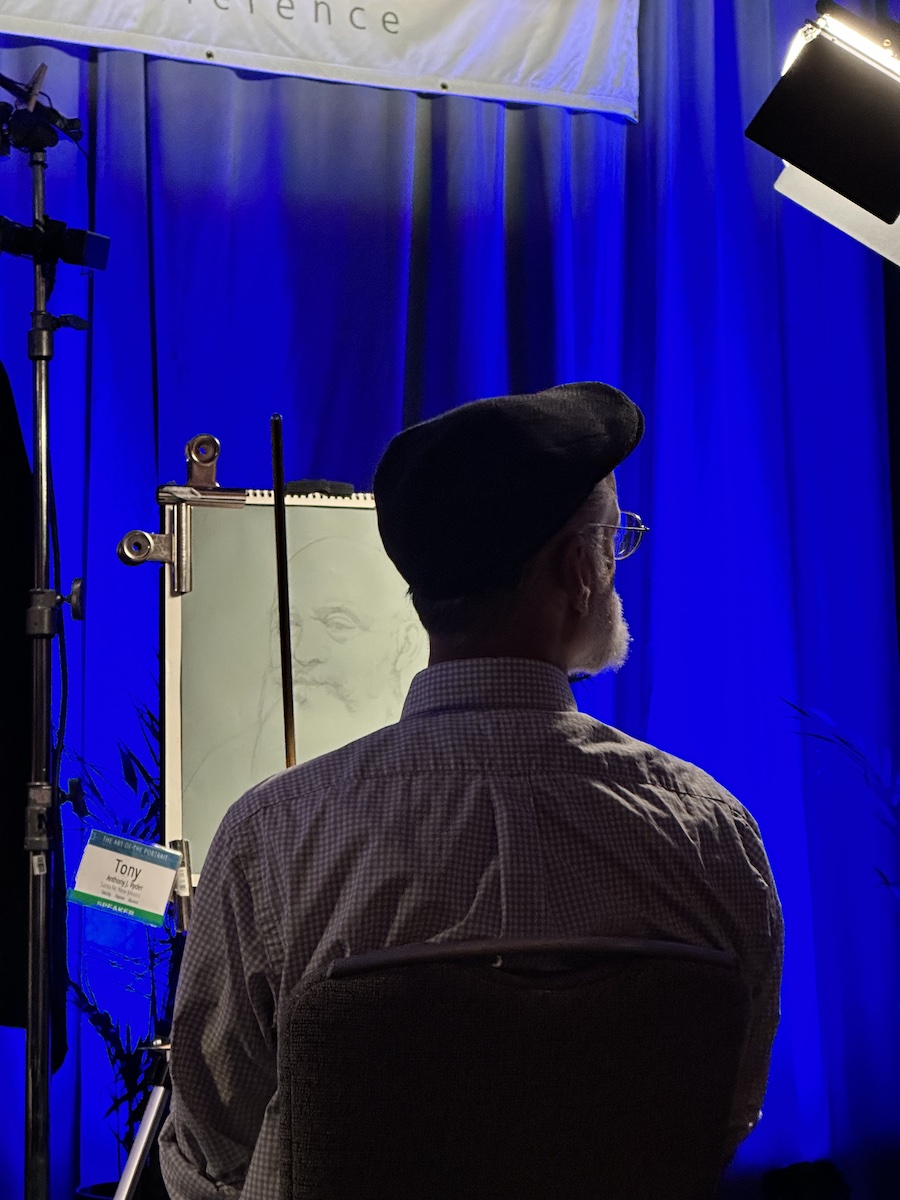
The autograph session on books written by faculty members, available for purchase at the shop allowed participants to have a dedication from their favorite artists.
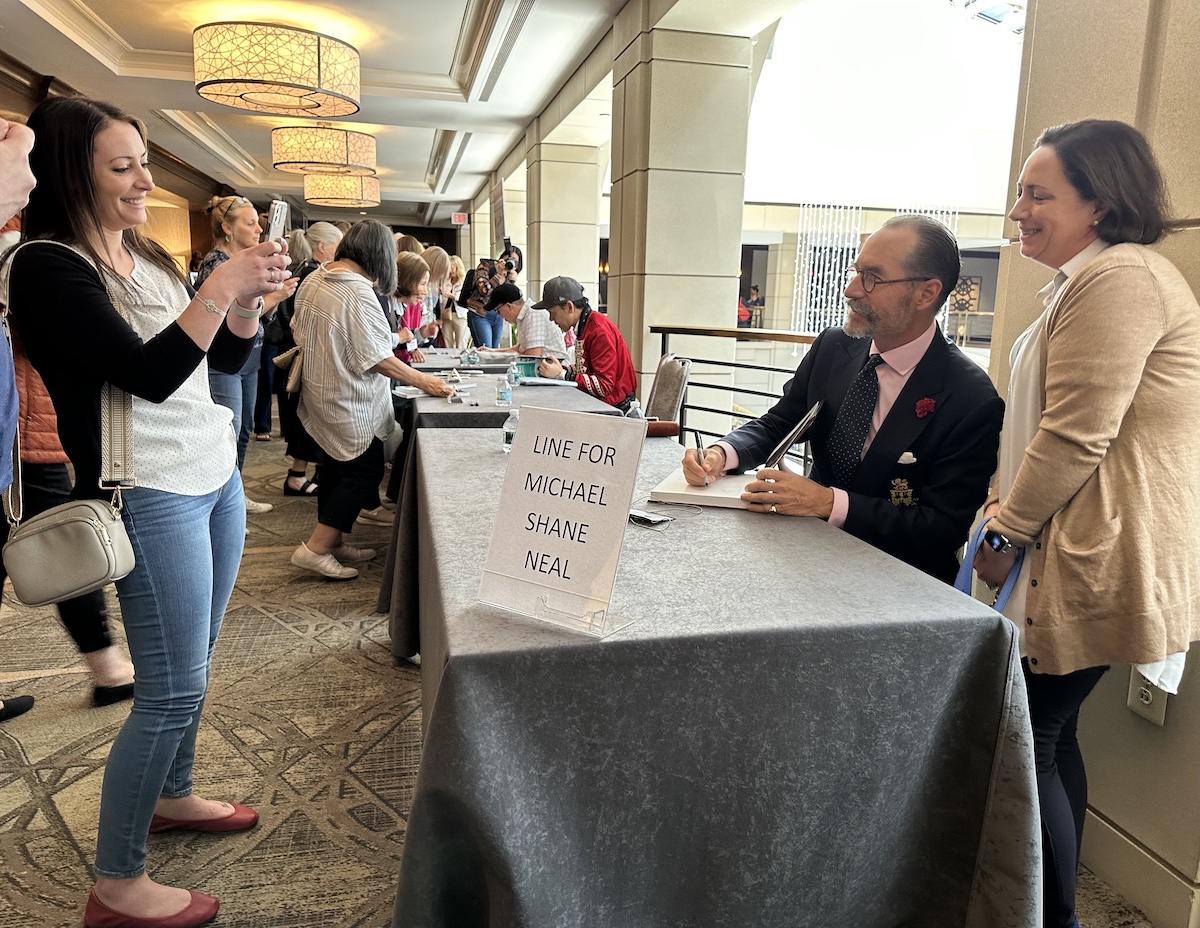
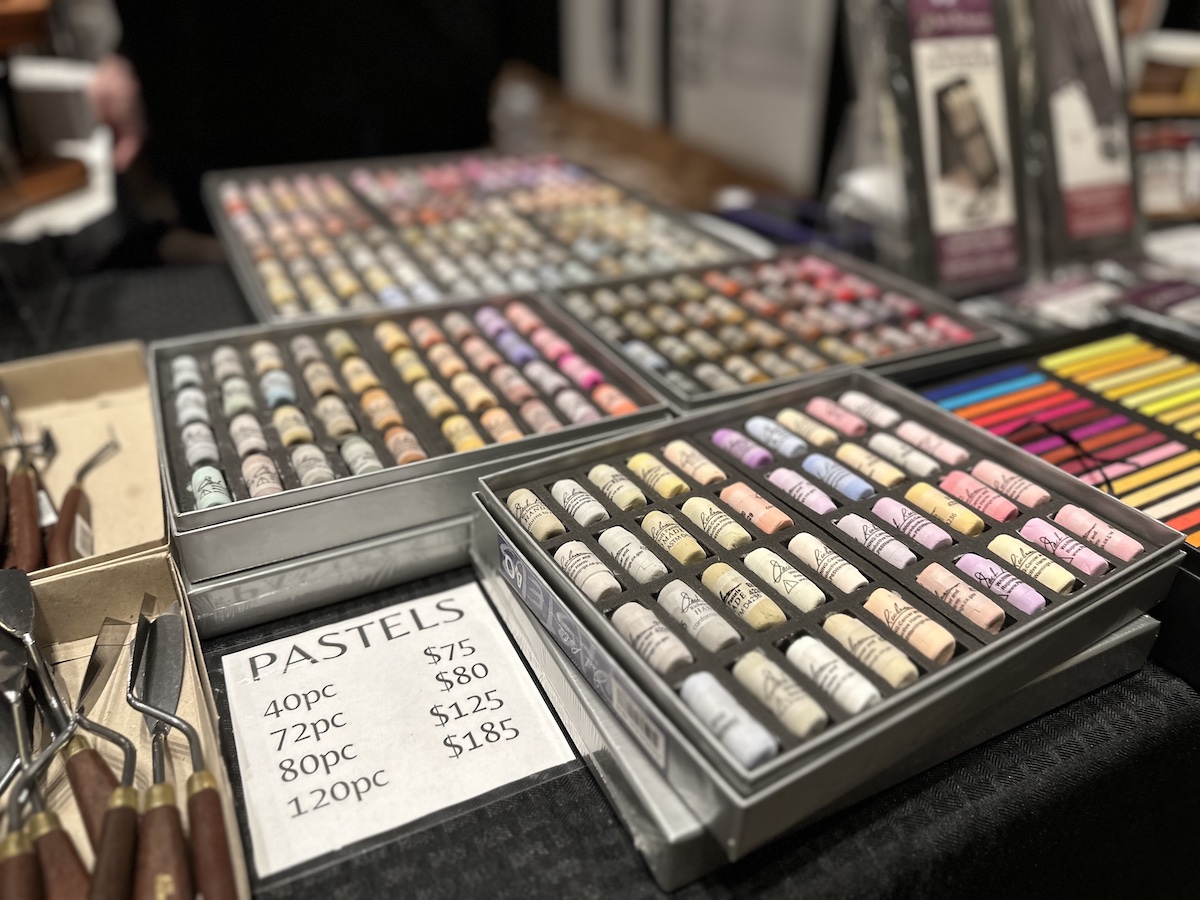
The afternoon was spent with the breakout room sessions set up on the second floor of the hotel, which is completely dedicated to the Portrait Society of America: this is an important factor because it allows participants to move freely to attend the various sessions being scheduled or to purchase the materials they need in the large room made available by the major international brands that sell their materials at lower than market prices. In the large hall dedicated to materials, one can also see the various artists at work in impromptu portrait sessions. The great king of the event is as usual Pierre Guidetti, iconic face of the art world, a unique character who lends himself well to modeling for his artist friends.
The afternoon sessions were a combination of theoretical and practical notions. To the theoretical notions imparted by the faculty members, participants put the information received into practice by drawing under the supervision of the faculty members.
“A quick look at the model can help to find a first impression: the first impression is the starting point in the representation of sketches,” suggested Jennifer Gennari.
“Give yourself options in order to see which is the better solutions for your drawing, before to enter into it with dark tones,” advised Susan Lyon starting with one of the most common mistakes made by artists when representing from life.
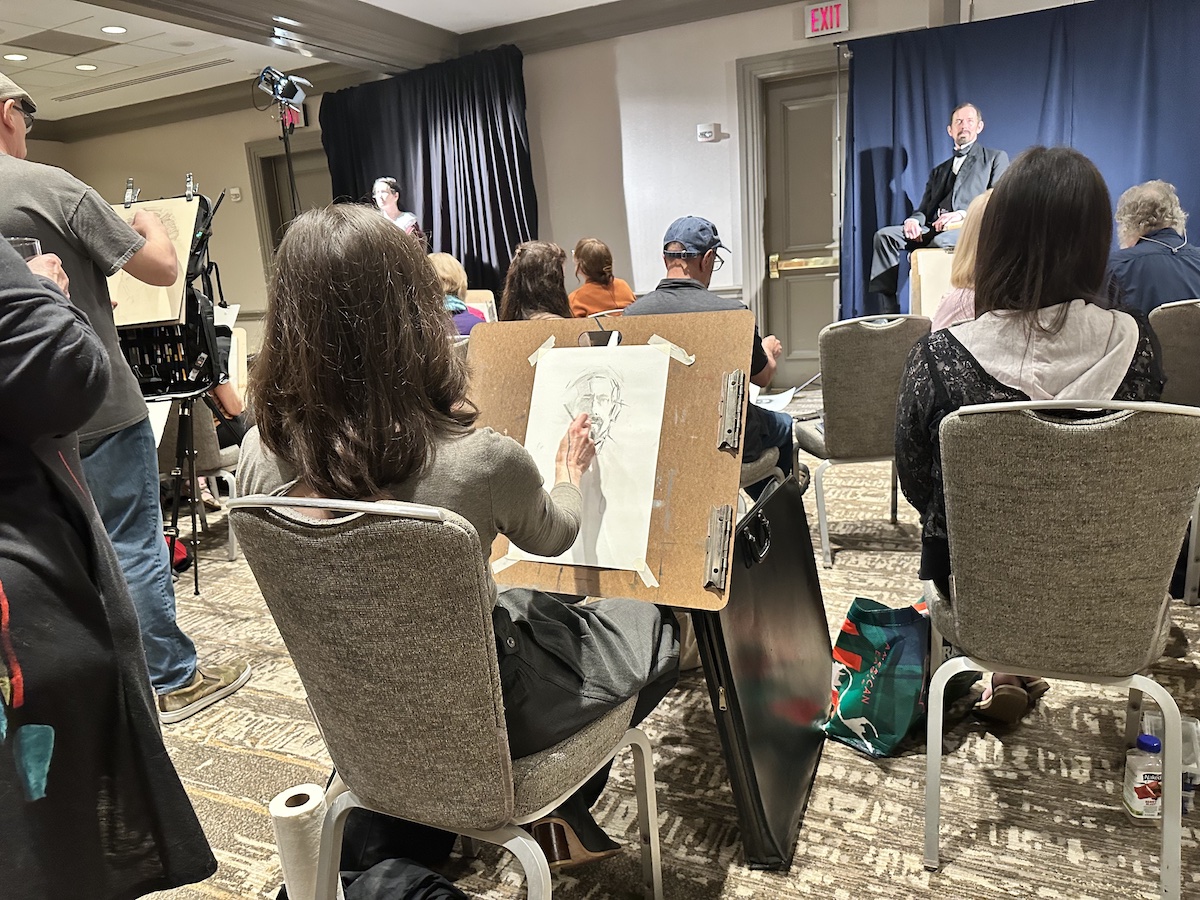
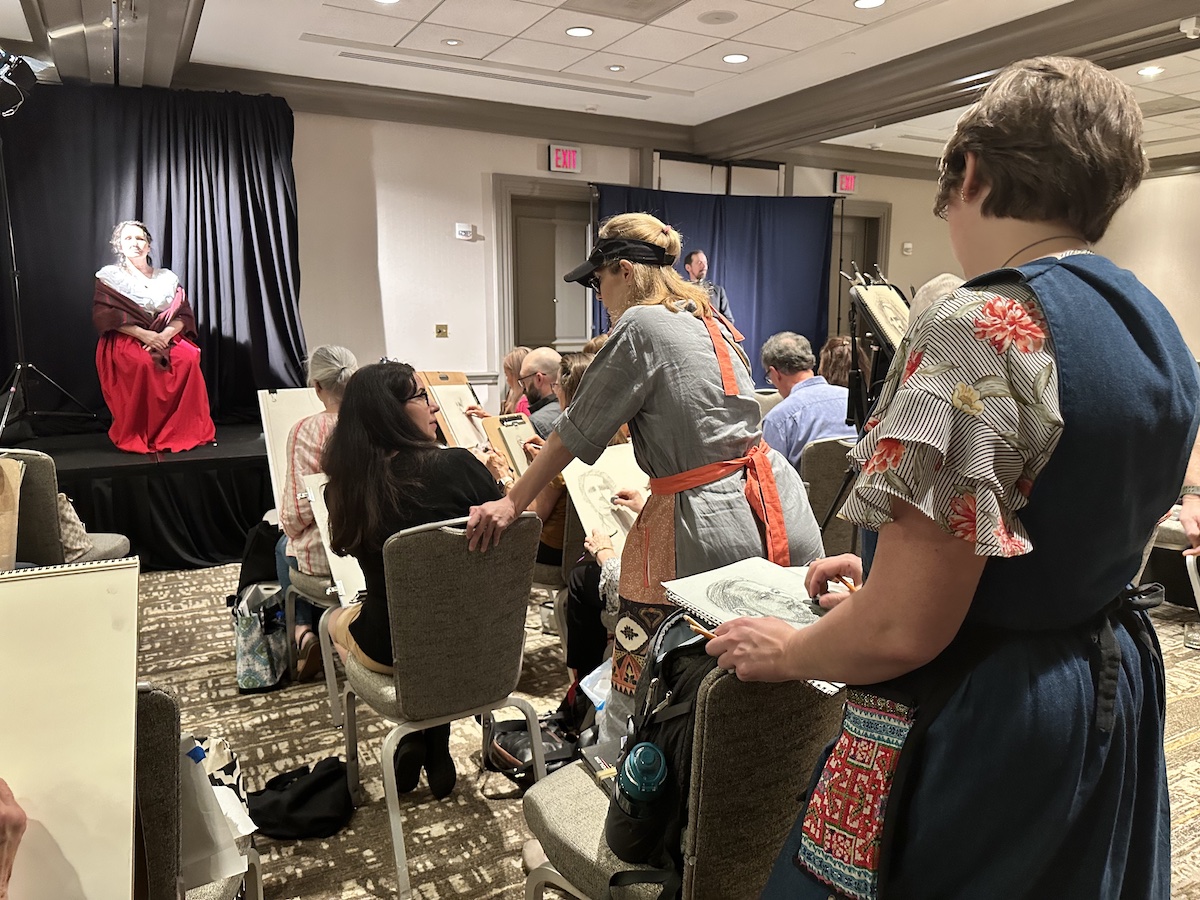
Dawn Whitelaw, an artist of great sensitivity and gentleness, in her session titled: “Backgrounds: Not Just the Leftover Space,” invited participants to work on the background, a way to understand how the background changes the perception of the image. She did this starting with the completion of small vignettes made available to participants who later did hands-on exercises to focus visual memory from an image depicted on the big screen. “A good habit to check the correctness of the drawing is to flip the paper over,” suggested Whitelaw, who has many years of experience behind her as a teacher.
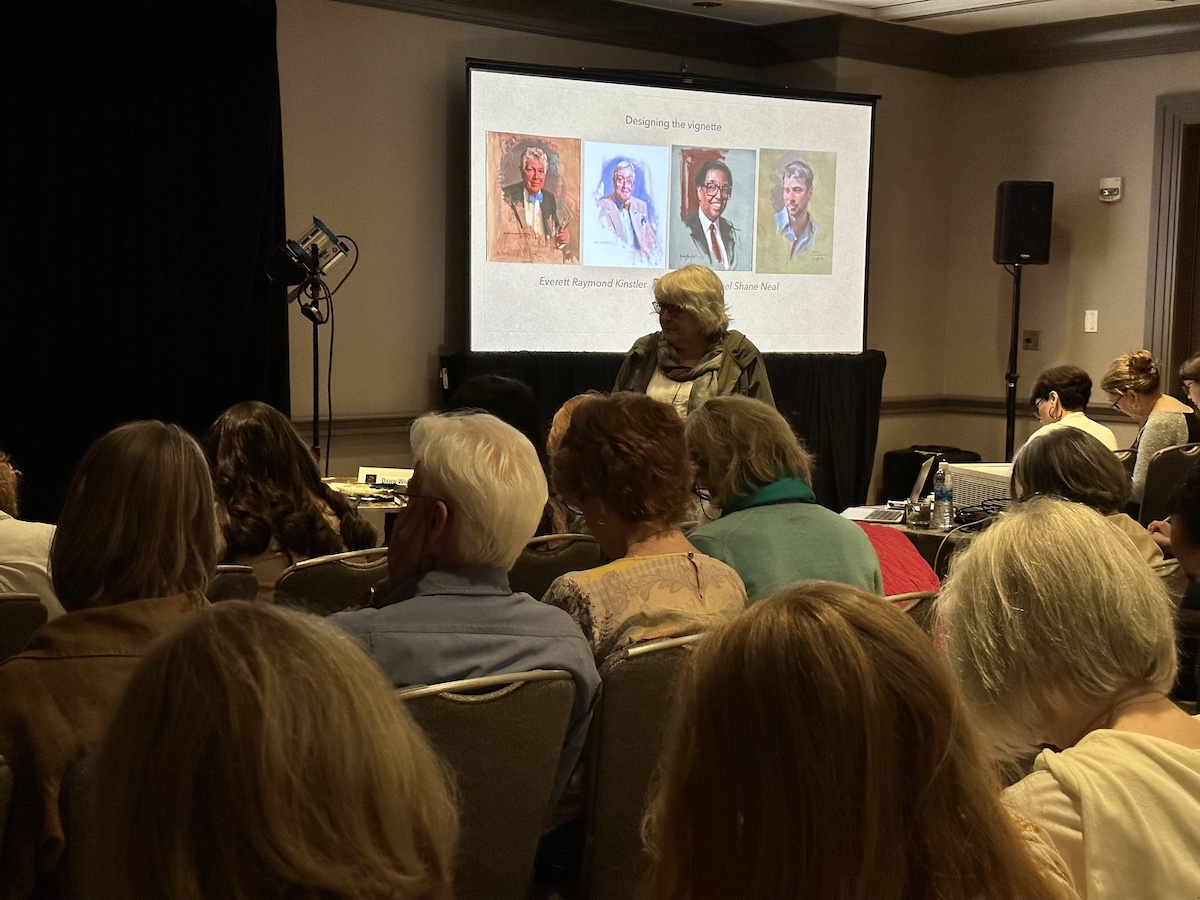
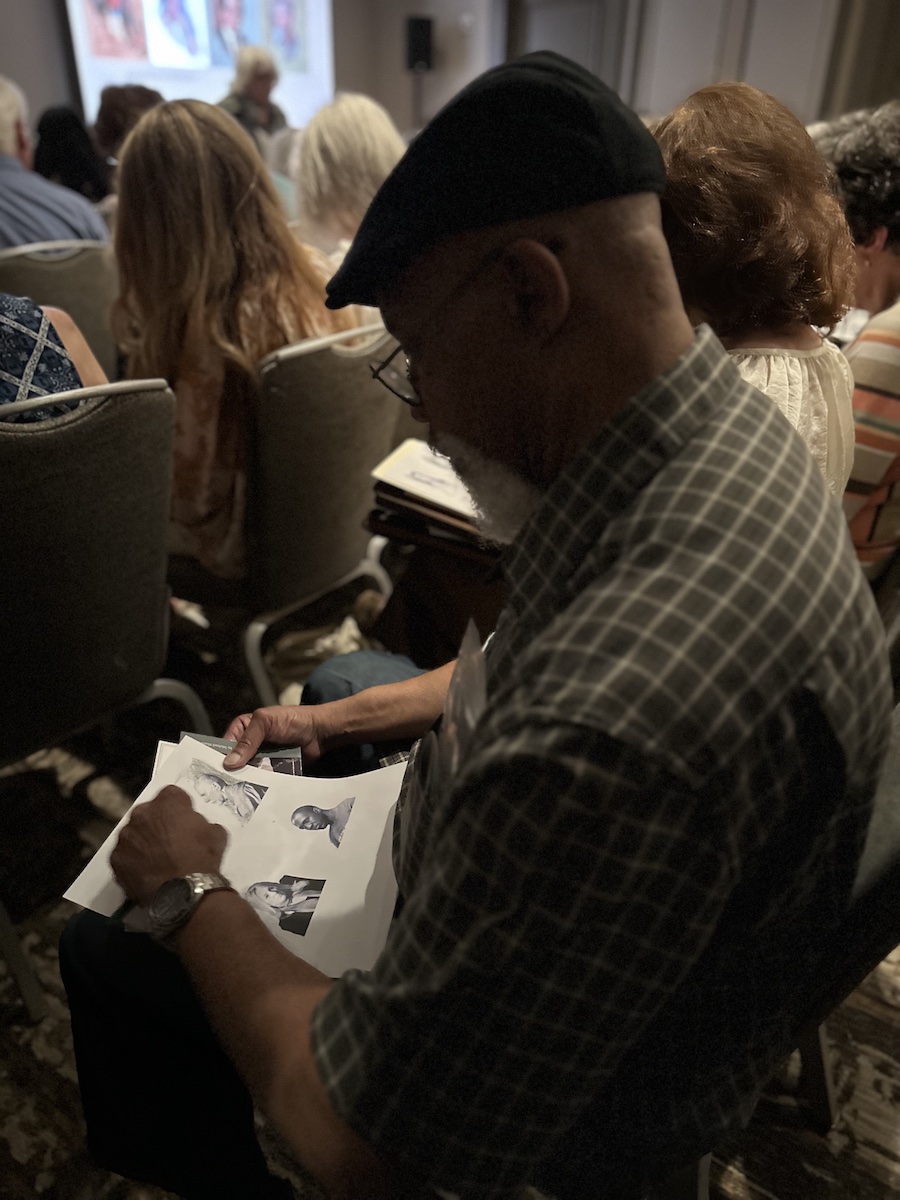
James Gurney, is an acclaimed artist specializing in plein air painting who made a demonstration entitled: The Rapid Block-In. Starting with a presentation of the materials he normally uses in plein air sessions making a clear distinction between: watercolors, gouache, casein and their rendering on a carnet de voyage. For the demo, he made John’s portrait: one of the most requested models during the convention. “It is essential, working in plein air, to make a quick block in of forms and then capture the light, in constant motion,” said Gurney.
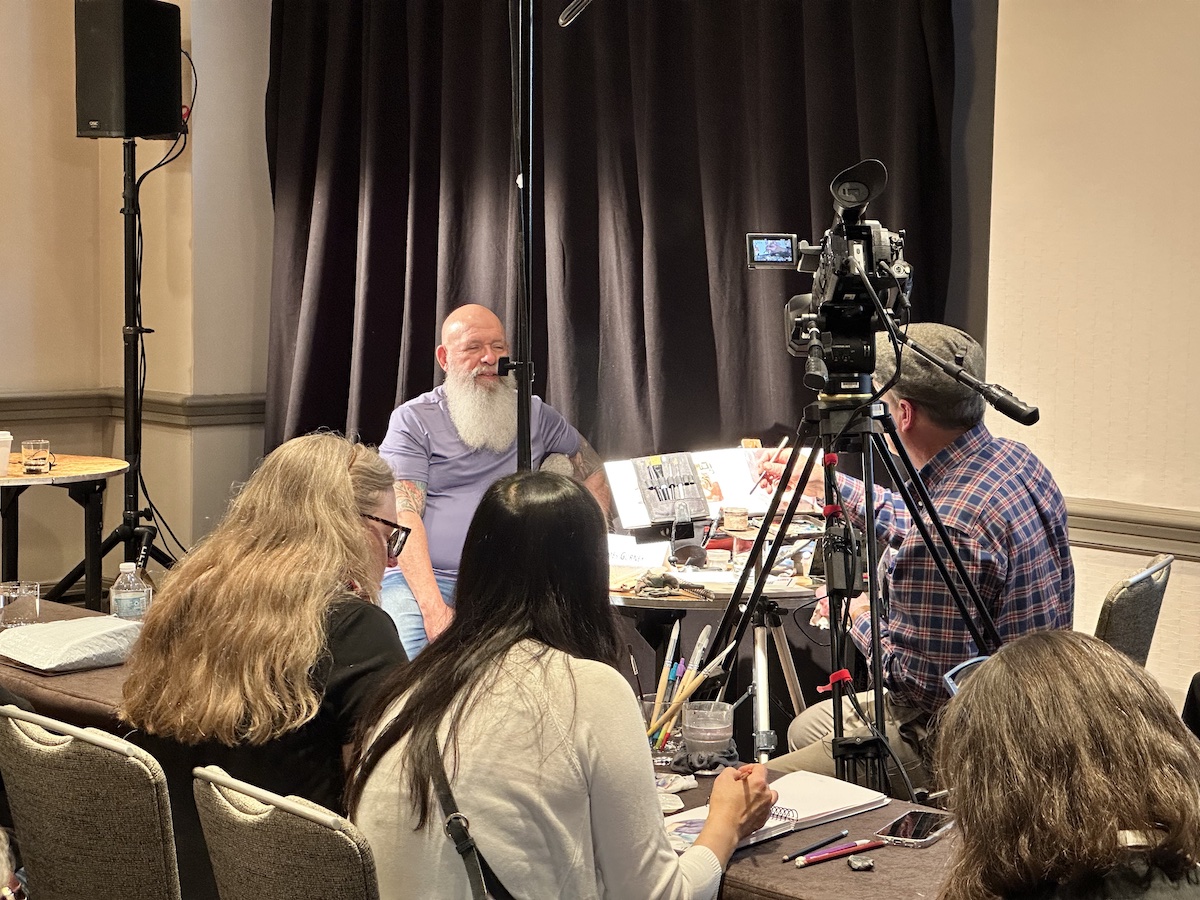
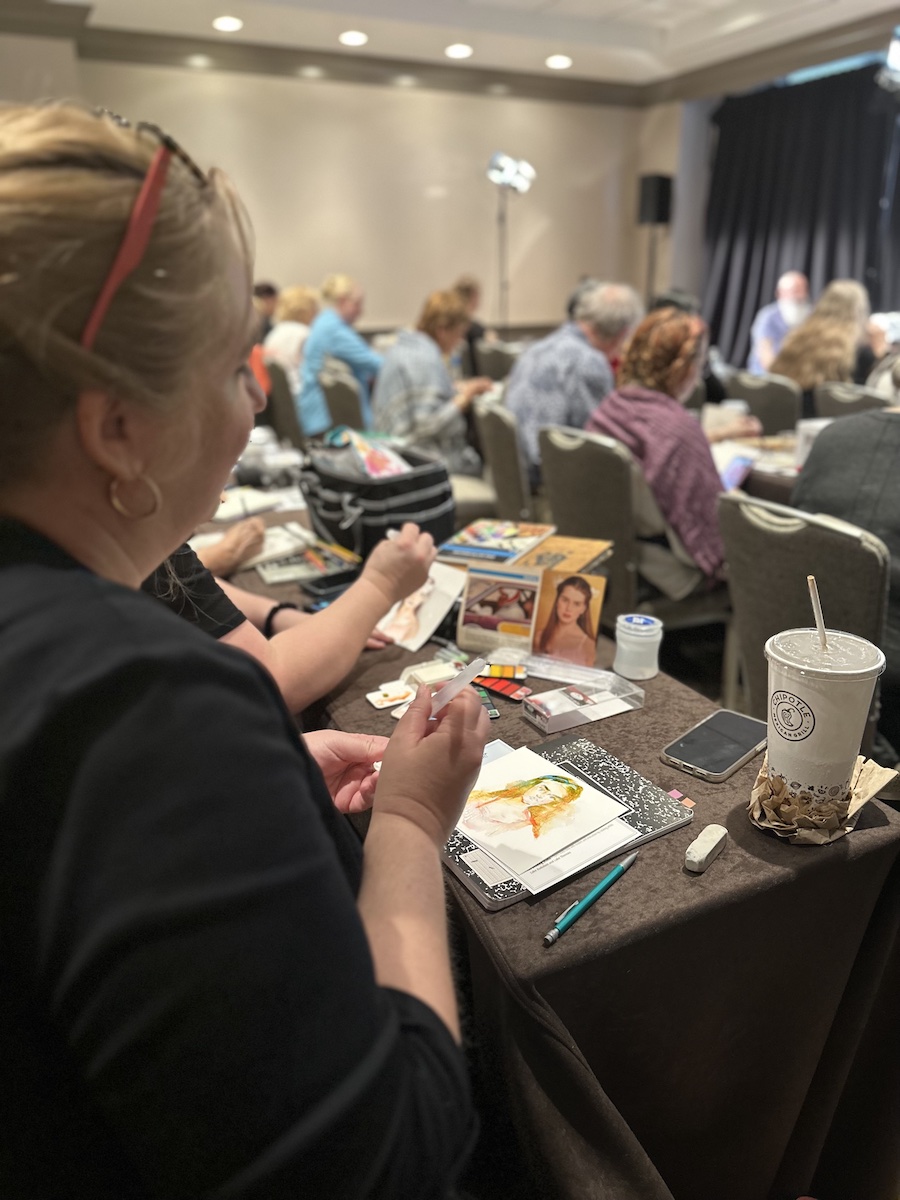
Acclaimed sculptor Rick Casali engaged participants in an interesting sculpting session entitled: “Planes of the Head: A Hands-on Approach.” Limiting himself, for obvious reasons of time to only face sculpture, Rick Casali stated that: “The approach to facial sculpture follows the same principles as drawing, so the perception of light changes as the planes of the face change.” Bringing as an example the notions imparted by George B. Bridgman in his book -a sort of bible to be followed to the letter- Casali stressed the importance of possessing the right “vocabulary and wisdom,” understood as the ability to organize knowledge optimally. These two elements, together with geometry -understood as the ability to organize forms in nature in a functional manner- are key elements in the creation of a sculptural work in which “the action of the pose” and the study of proportions account for 80 percent of the work’s success.
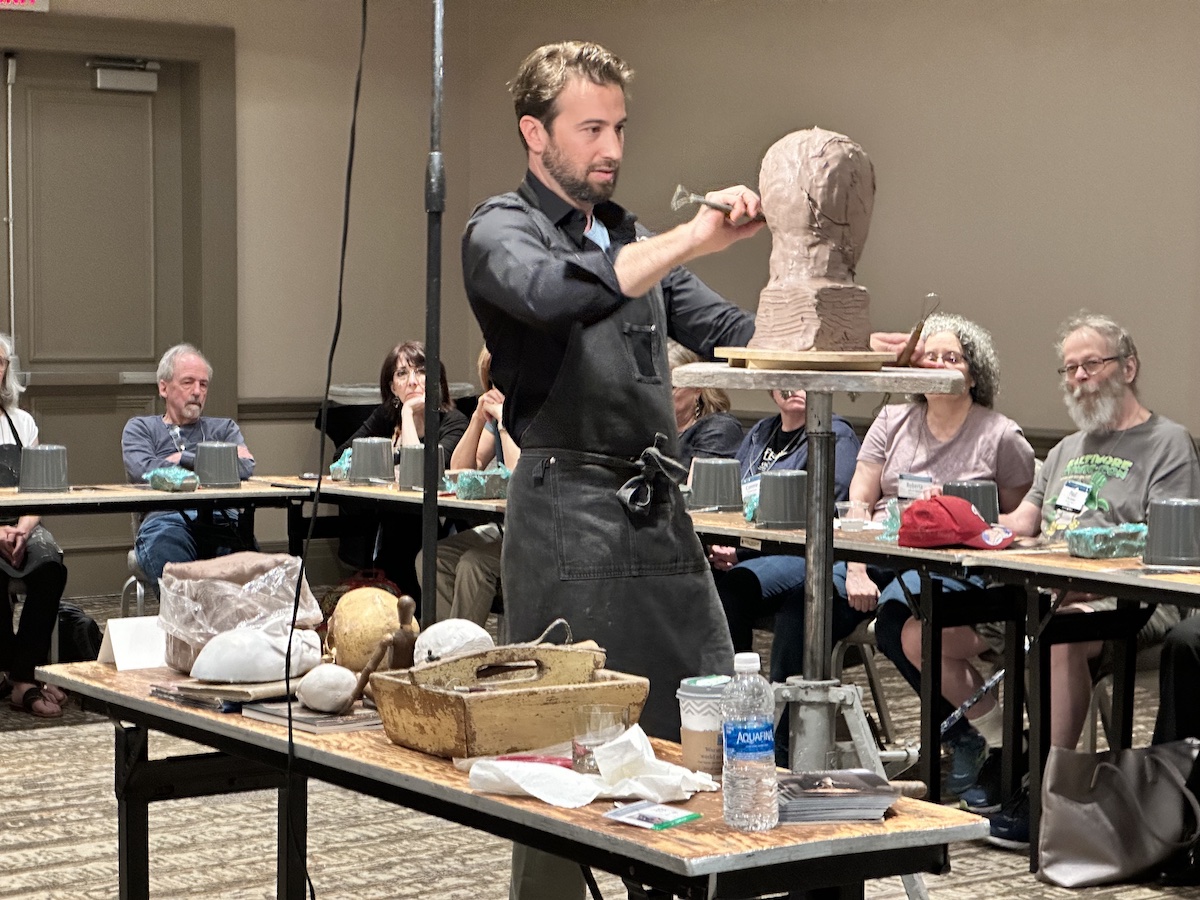
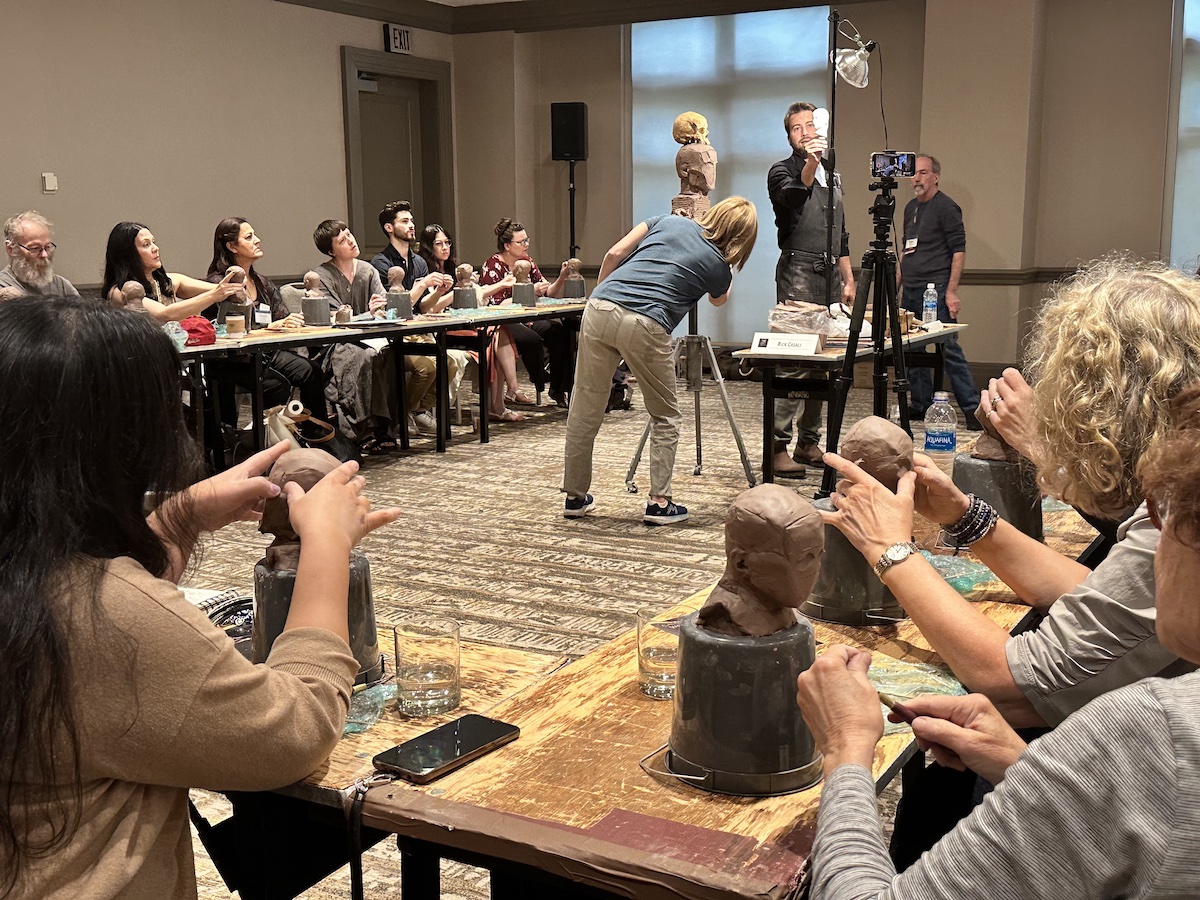
Luis Carr in his demo, “Composing a Portrait,” offered important compositional elements to consider when creating a portrait.
“I spend a lot of time with my clients to figure out what is the most natural pose that will highlight their figure and its narrative,” said the artist. To help participants in creating a figurative composition Carr offered a lot of information based on his personal experience. The first element to consider is light: the more diffuse the light, the softer the edges and shadows will be; light closer to the subject, on the other hand, emphasizes hard edges by increasing contrasts. The compositional choice also concerns the representation of the subject, which can be: half figure, 3/4 figure and full figure: half figure also implies the study of hands and fingers, elements that offer important narrative information but require longer study and execution time. The background is another distinctive element: for its realization Carr helps himself with a drape arranged in such a way as to create movement around the subject. Finally, the closure of the composition has its importance, and in this context we must take into account the Gestalt theory plays a key role.
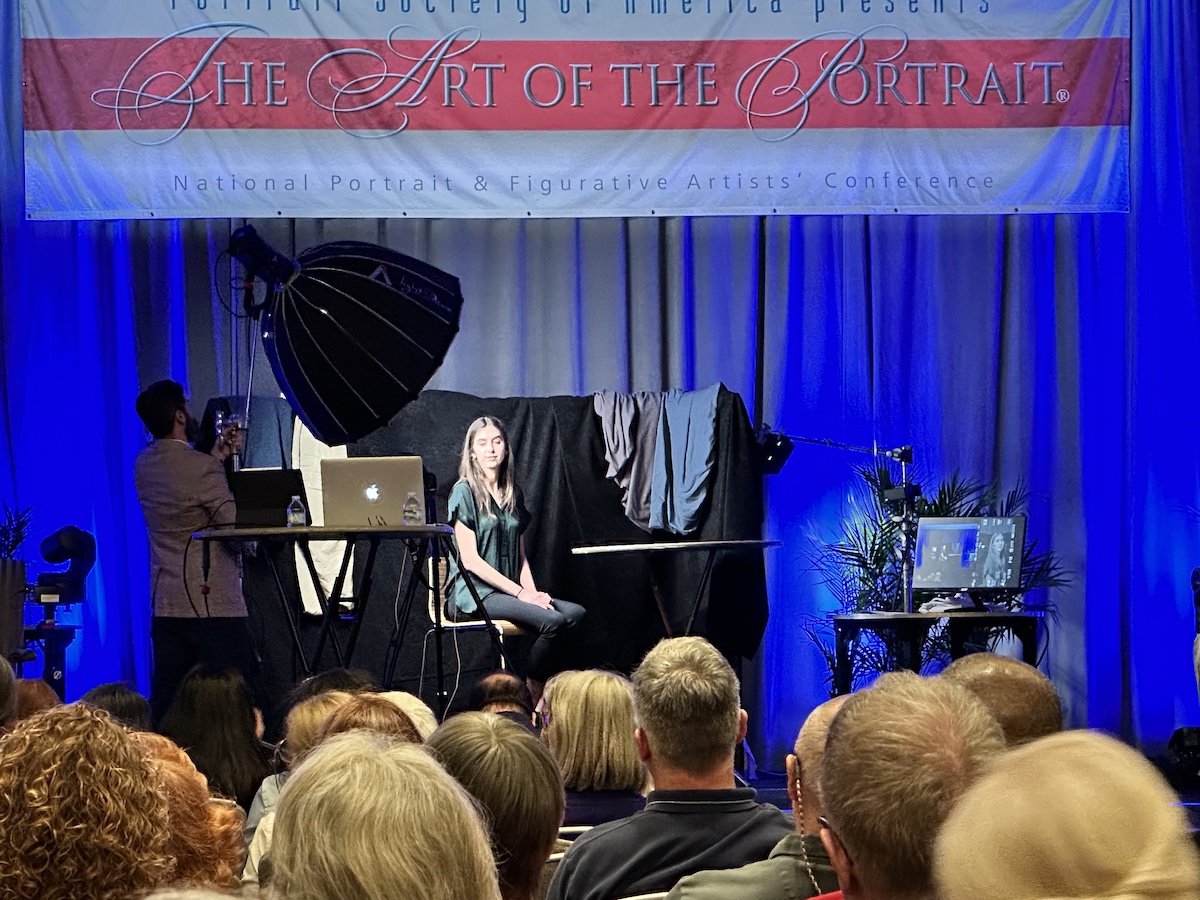
The demonstration day ended with another dual demonstration by Robert Liberace and Mary Qian based on the concept of “Rhythm.”
The concept of rhythm in artistic representation is inherent in every stage of the compositional process: from the posture assumed by the model, in this case the extraordinary Nat who stood for a full two and a half hours with his torso in torsion harking back to the drama that characterized the works of Pierre-Paul Prud’hon (among Liberace’s favorite artists), to the brushstrokes with which the artists compose the figure and to the harmonic connection of the various parts of the body.
This demonstration is yet more proof that there are different ways to achieve figurative art: taking for granted certain concepts that underlie drawing and figurative composition in general, it becomes clear that there is no right or wrong way to approach the human figure. The artists themselves have highlighted two different ways of proceeding: while Mary Qian makes a background, working later on the human figure, of which she highlights the masses, emphasizing the shadows that define volumes of the anatomical structure only at the end of the composition, Liberace made a basic drawing in which he mapped out the pivotal points of the skeletal and muscular structure, which he harmonized with the mid tones in an extraordinary compositional balance.
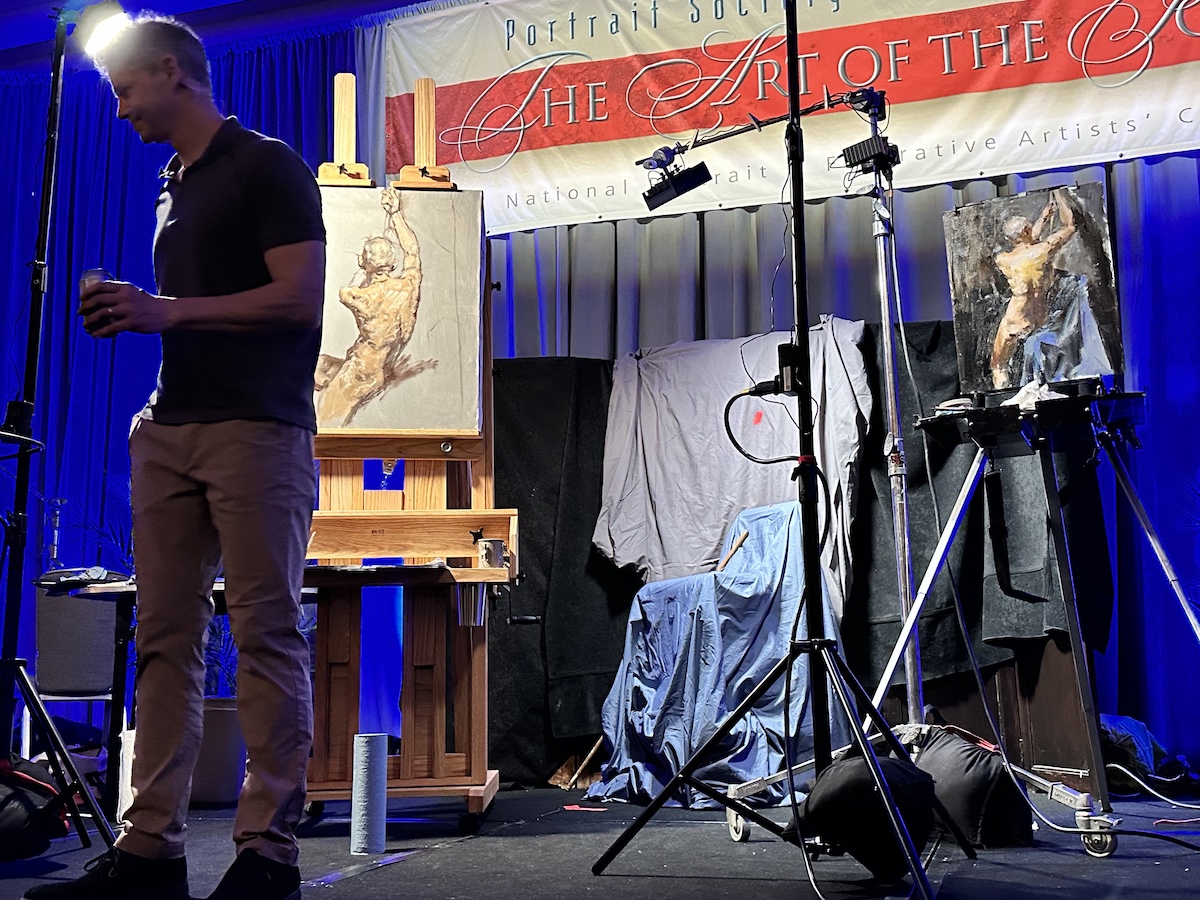

Many important events took place during the day: from the closing of the Silent Auction, by which the works created during the Face-Off of a no-holds-barred competition to win the favorite piece (all of them in truth) were auctioned off, to the sale of the works created by the “6 x 9: Limited Size, Unlimited Talent – A Mystery Art Sale” that represents one of the most intense moments of the convention. However, the most important event was the opening of the hall in which it is possible to admire the finalist works of the International portrait Competition. This year’s finalist artists, among whom there will be not only the winner of the competition but also the winner of the prestigious Draper Grand Prize, who will be named tomorrow following the gala evening, there are: Frances Bell, Scott Burdick, Matteo Caloiaro, Rick Casali, Chung-Wei Chien, Joseph Daily, Ruth Fitton, Hiroshi Hayakawa, Ronald Hicks, Fengshi Jin, Pramod Kurlekar, Sean Layh, Jie Liu, Paul Newton, Janvier Rollande, Robert Strickland, Alex Venezia, Jennifer Welty e Shane Wolf.
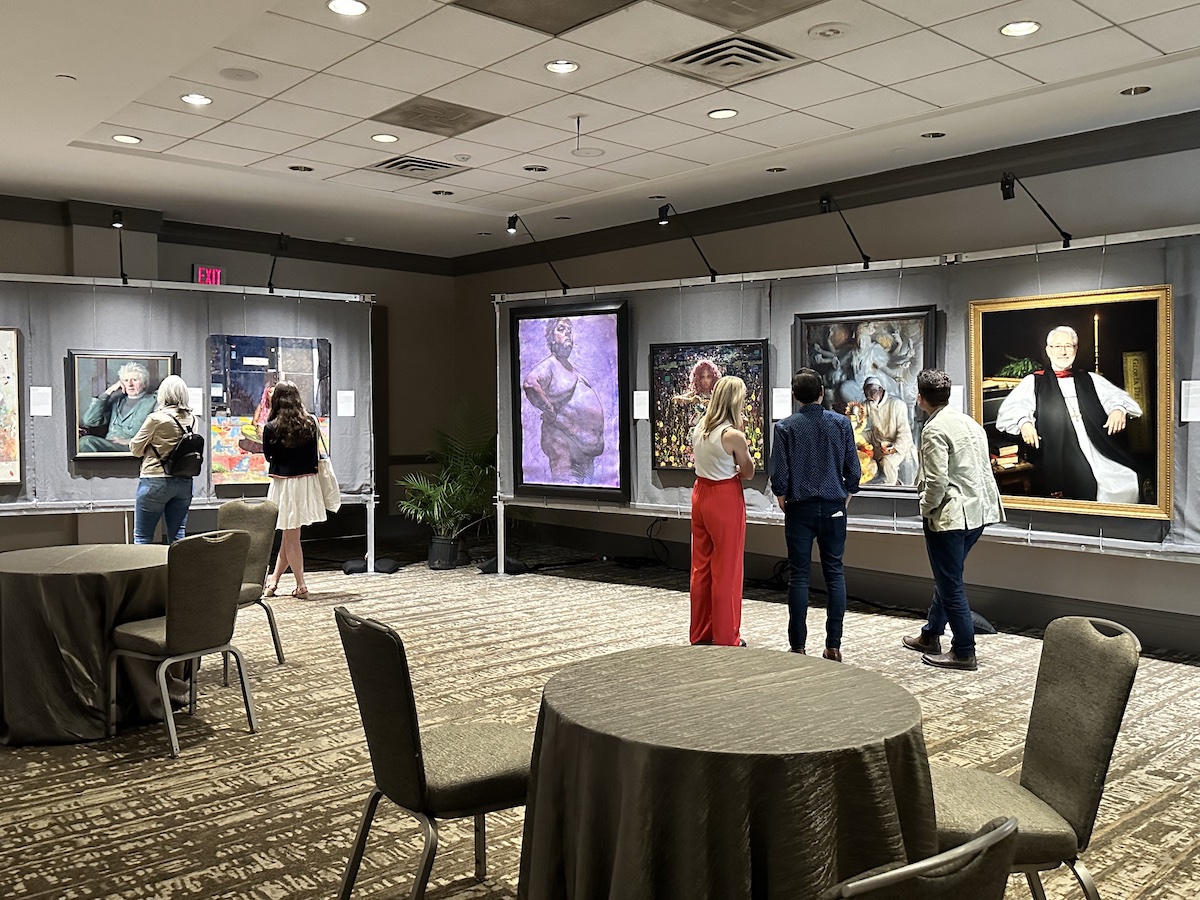
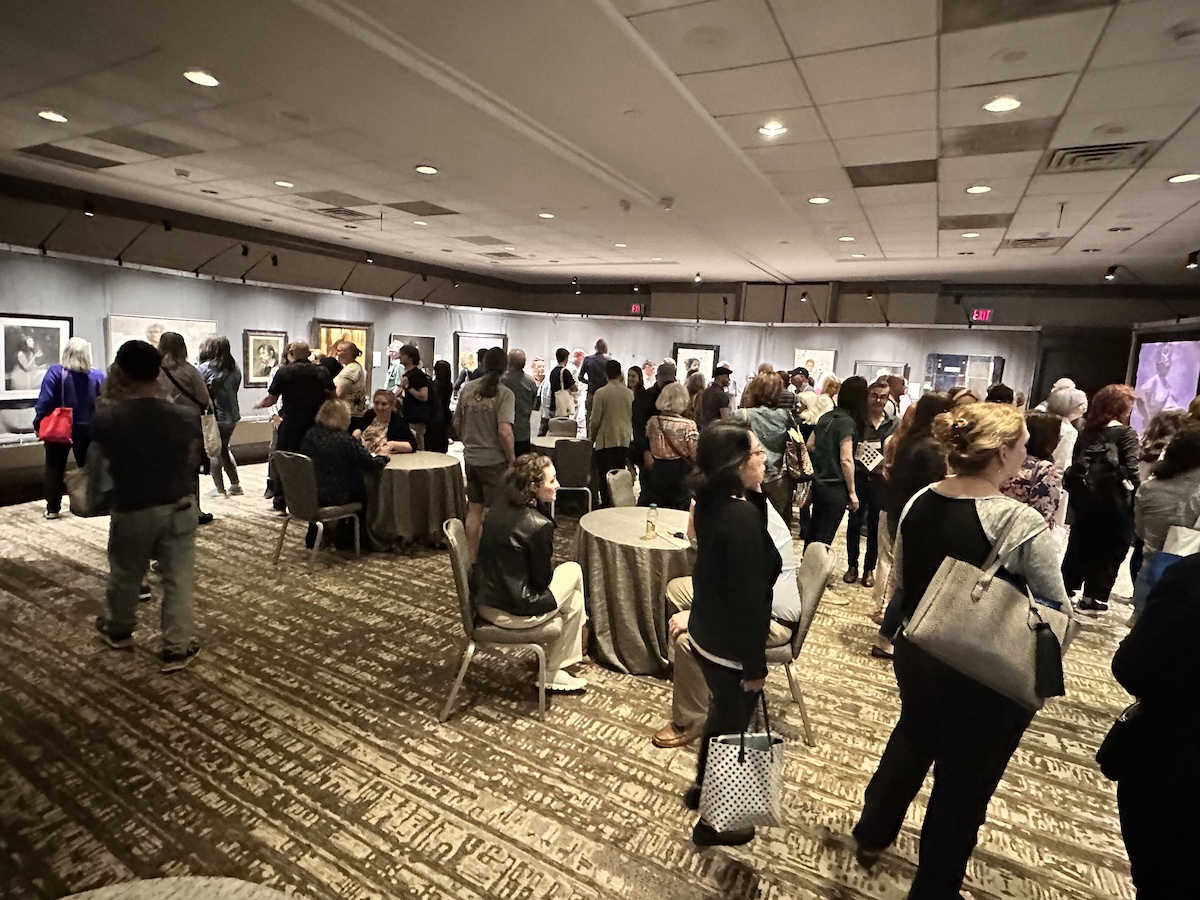
The day has come to an end and Miami Niche looks forward to another exciting training day tomorrow filled with surprises and with the announcement of the winners.
( on the title, some of the majestic works of the finalist of the International Portrait Competition )
